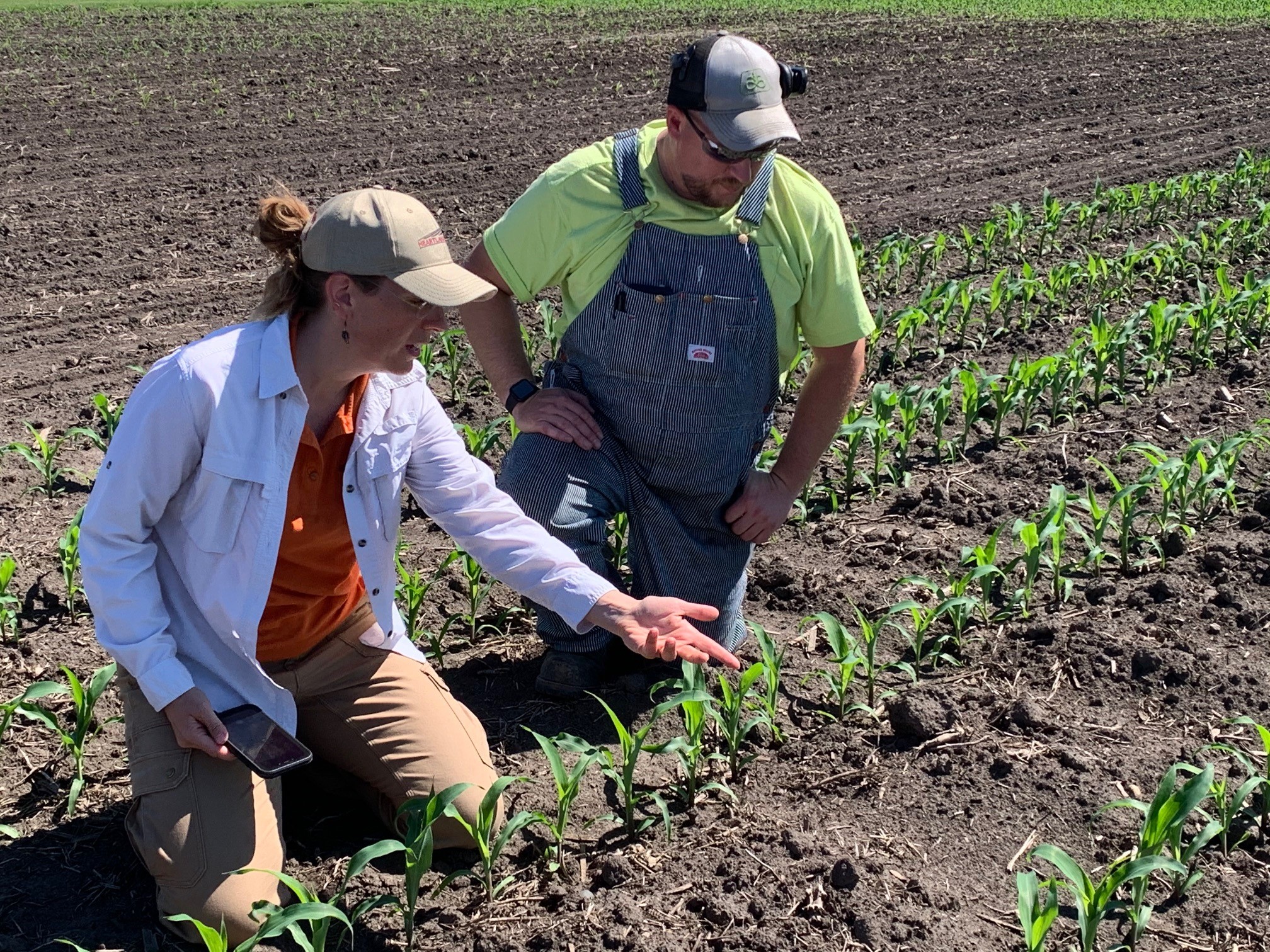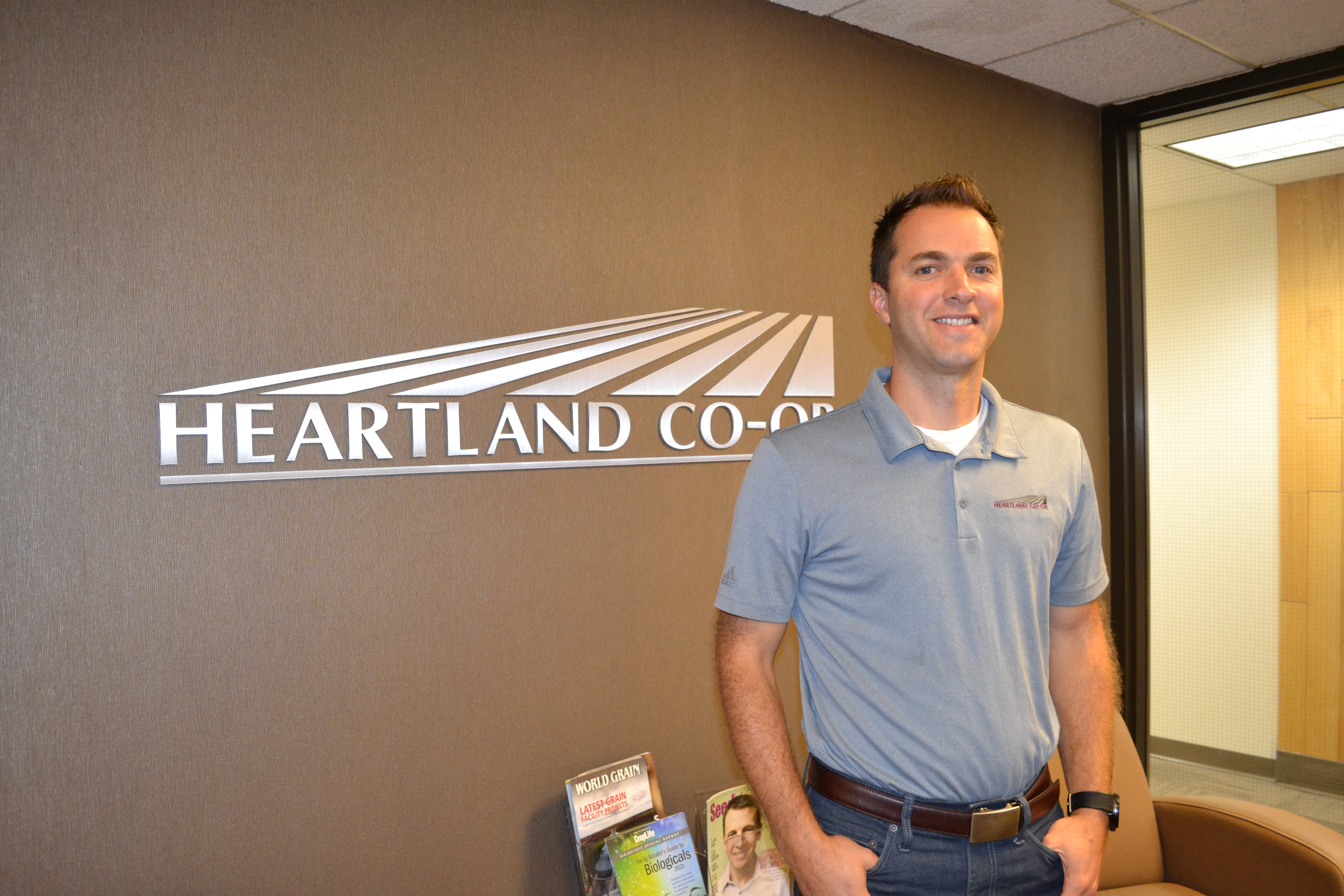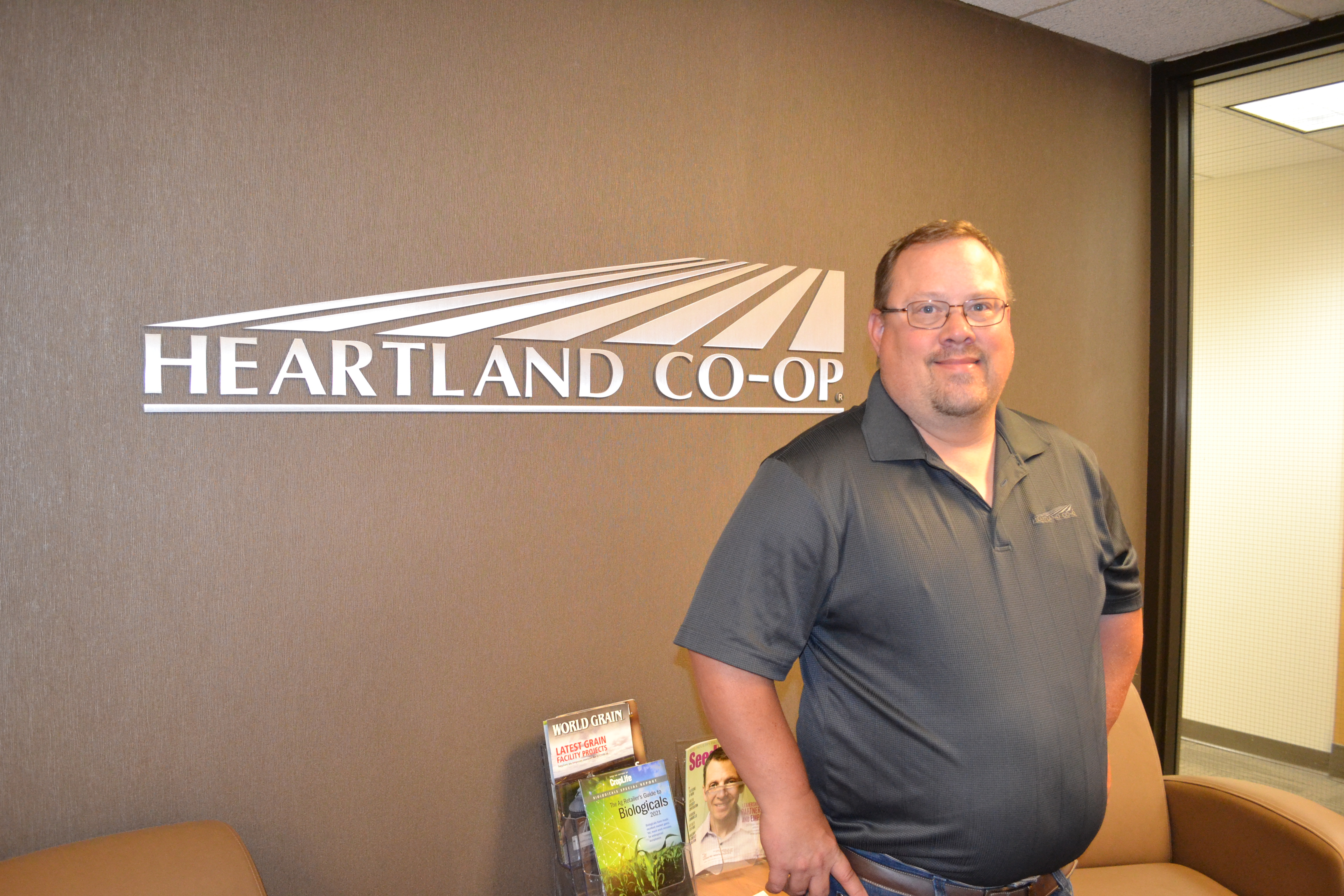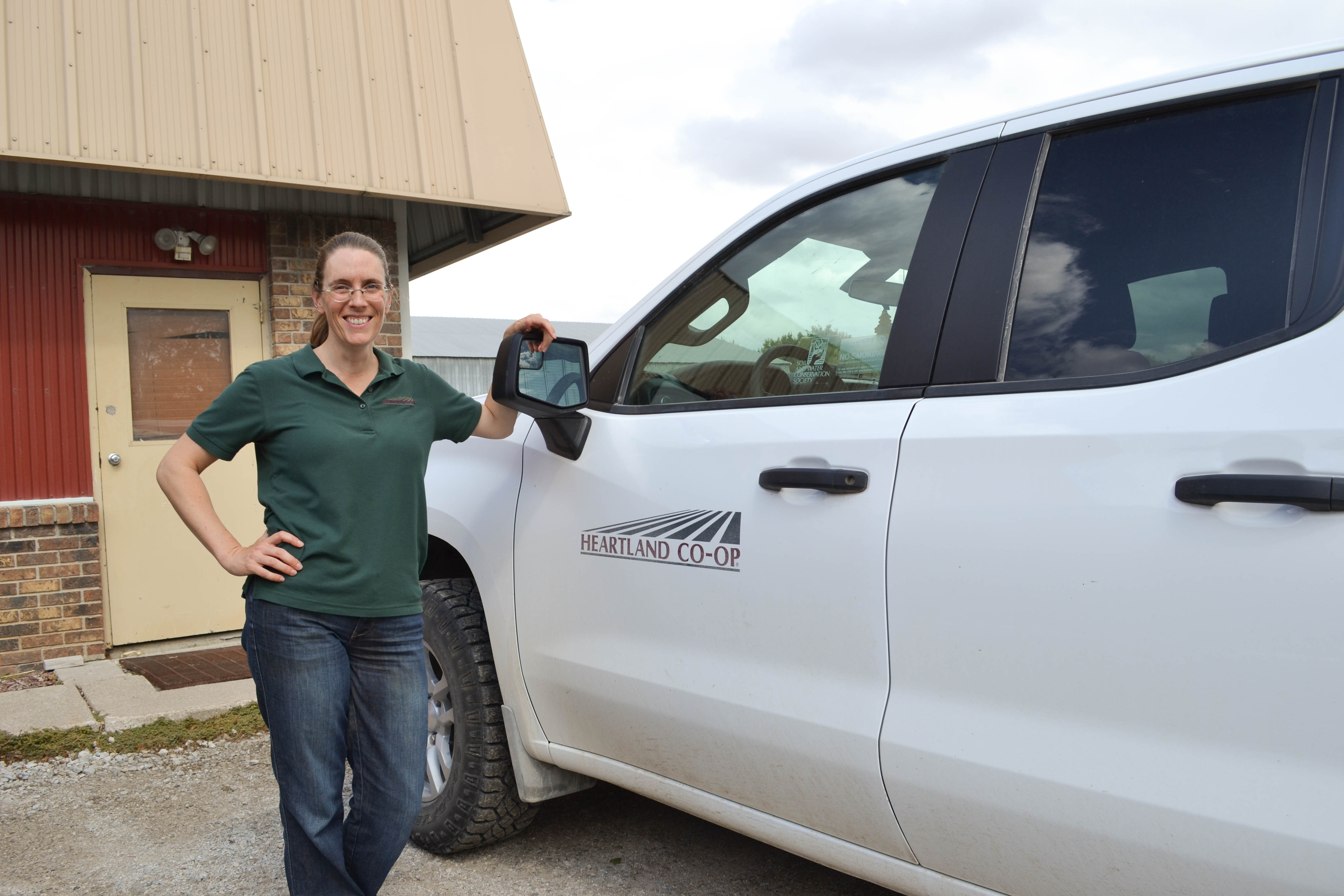
Ruth McCabe, conservation agronomists works with a producer last spring. McCabe is a part of a new conservation agronomist network and works within the Heartland Co-op territory. (Photo: Ruth McCabe)
Conservation meets agronomy
October 21, 2021 | Kriss Nelson
A network of conservation agronomists, developed in August of 2020, has been making great strides in connecting with ag retailers, farmers, and landowners.
Heath Ellison, Iowa Soybean Association (ISA) senior field services program manager said in addition to the in-house conservation agronomists on staff at ISA there is a broader conservation agronomist network, which includes two agronomists employed by Heartland Co-op.
Conservation agronomists, Michael Fritch and Ruth McCabe are serving the Heartland Co-op territory – positions made possible by a grant from the National Fish and Wildlife Foundation, managed by ISA, and supported by multiple partners, including Heartland Co-op.
Thomas Fawcett, director of environmental resources and precision ag at Heartland Co-op said ag retail is ready to embrace conservation.

(Thomas Fawcett, director of environmental resources and precision ag at Heartland Co-op)
“We recognize we need to take a different approach to actually implement conservation,” Fawcett says. “To really see the Iowa Nutrient Reduction Strategy take the next step forward and really start to expand to more growers, more acres, more targeted areas, we need to take a more serious role and this is where the idea of the conservation agronomist really emerged.”
Fawcett credits ISA for procuring the funding for Heartland Co-op to hire McCabe and Fritch – an opportunity he credits to developing a multi-year program and building profitability into the space of conservation for the ag retailer.
“(ISA’s) work to pioneer space for the conservation agronomist has been incredible,” says Fawcett. “We appreciate the work Roger (Wolf) and Heath (Ellison) and the team has done to make the conservation agronomist role a reality in Iowa.”
In the 14 months since the program was implemented, Fawcett has seen some great success from McCabe and Fritch.
“They have been able to engage agronomists in conservation discussions,” he says. “We want to see through their involvement all of our agronomists feeling comfortable bringing up conservation with growers they deal with because they know they have a support system behind them.”
Michael Fritch
To get started in his role as a conservation agronomist, Fritch said it was important to get to know as many people involved in the conservation arena.
“We started from the very beginning and as we got to know everybody in conservation, we started bringing farmers in and it has been nothing but conversations with farmers over cover crops, edge of field practices, funding, carbon markets. It has been a lot of fun. It has been a fast ride,” says Fritch.
It is not only their job to understand the agronomy side of conservation, but to be able to relay and interpret funding available to farmers and landowners.

(Michael Fritch)
“It is our job to understand where the cost share dollars are coming from so we can help align the practices and help get some return on investment for the farmers so they can apply that to their farming operation,” he says.
They’ve also stepped up to assist with Polk County’s saturated buffer program and have been working alongside John Swanson, watershed management authority coordinator for Polk County.
“We offered to partner together,” says Fritch. “We are the trusted farm advisor out here. We know the farmers. It has been a whole lot easier conversation going that way. It has been successful, and we are blowing targets away.”
Ruth McCabe
In the time Ruth McCabe has served as a conservation agronomist at Heartland Co-op, she has learned one big lesson.
“There is a huge demand in private ag retail for exactly what Michael, I and the other conservation agronomists at the Iowa Soybean Association are doing,” she says. “I think there has been a huge open arms welcome with what we are doing.”
What can a conservation agronomist do for the landowner and farmer?

(Ruth McCabe)
“If a farmer wants to manage their cropping system in a way that conserves nutrients, introduces habitat or builds soil health, they’re probably going to reach out to us. Those are the agronomic systems we are most familiar with,” she says.
Like Fritch, McCabe knows acquiring funding for conservation practices can be confusing and is ready to help farmers and landowners navigate through that process.
“We bring along all of the information from state, federal, private and carbon funding programs. We go through them with the landowner and explain options, pros and cons of each,” McCabe says. “Farmers have found we can help steer them toward one or two things that will have the greatest impact – the greatest potential.”
Goals of the conservation agronomist
The ultimate goal of the conservation agronomist program, beyond seeing more conservation practices implemented on Iowa’s landscape - is to prove the value of the conservation agronomist in the ag retail space.
“We want to continue to partner with the Iowa Soybean Association to see the conservation agronomist role become an industry standard – to see what this role can bring to established conservation groups in Iowa, to ag retail and most importantly to growers,” says Fawcett.
McCabe said her overarching goal is to make conservation accessible to every farmer. She also wants to help farmers realize the conservation practices they’re currently utilizing.
“Variable rate nitrogen applications, reduce tillage, fertilizer applications in the spring instead of the fall – none of that might seem like conservation, but it is,” she says. “We need farmers to realize not every conservation practice works on every acre, but for every acre there is a conservation practice that will work.”
Fritch said they need to keep working hard to lead as an example.
“We know this is a very important position out there. We are seeing how this position is helping conservation efforts and I hope to see it expand and make as big of an impact as we can on the environment,” says Fritch. “At the same time, being sustainable and helping farmers be profitable.”
Looking ahead
Ellison said the network of conservation agronomists continues to grow. By spring 2022, he is anticipating the addition of another ISA conservation agronomist in the eastern part of the state working with Linn Co-op. Funding for this position has been made possible through a NRCS Regional Conservation Partnership Program grant awarded to the city of Cedar Rapids.
“We are just really excited to have the opportunity to work with the ag retail system at a level we have never had the opportunity to work before,” Ellison said.
Back